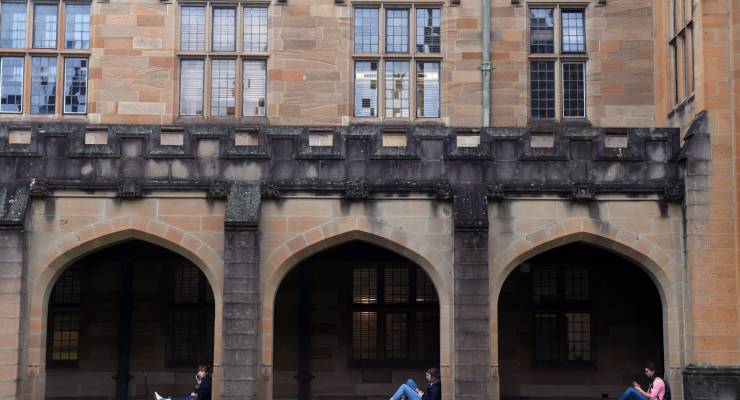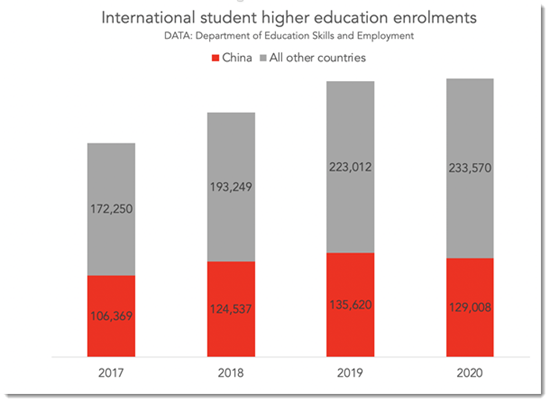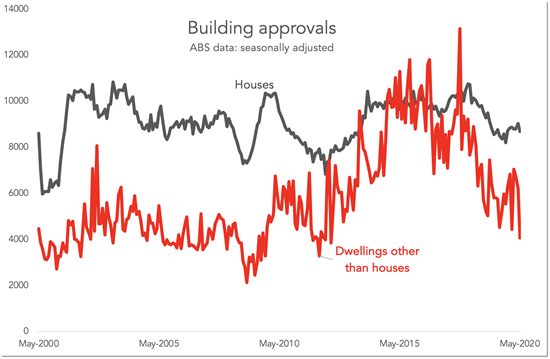
If a new survey conducted in China by researchers from Swinburne University of Technology is self-fulfilling, Australia’s higher education sector is set to be eviscerated.
Just over 1000 Chinese students and prospective students took part in the survey, reported in The Conversation, in early June. Fewer than 50% of those who had studied overseas planned to return and 60% of prospective international students were reluctant to study abroad.
This represents a giant upheaval in what has long been a growth industry — Chinese families spend very large sums on education, and international qualifications have for a long time had a good reputation in China. But in the time of coronavirus there are more important concerns.
The most substantial factor dissuading Chinese students from returning was “warnings from the Ministry of Education to be cautious about studying in Australia due to the ‘danger’ of COVID-19 and ‘discrimination’ against Chinese”.
Of course it is worth considering just how forthcoming survey respondents were. It may be unsurprising that they publicly say they will take the government’s warnings into account.
But other responses were less to do with compliance with government warnings. Students cited media reports of discrimination and abuse of Asian students and a deterioration in Sino-Australian relations.
This is a fast-developing economic crisis for Australia.
Education more than just an export
Foreign students are an enormous contributor to Australia and not just through the tens of thousands of dollars in fees they pay upfront each year. Education is more than just an export because students live, work and consume here.
As anyone who has looked at population growth knows, permanent migration is not the real swing factor for Australian population. It is temporary visas that swell the population. Foreign students are a big part of those visas.
There are several categories of foreign students. Higher education is the largest, vocational education and training comes next. Chinese students are heavily represented in higher education as this graph shows.

In 2018, 39% of all foreign students enrolled in higher education in Australia were Chinese.
On top of the approximately 130,000 Chinese students enrolled in universities, there are a further 50,000 enrolled in higher education, schools, English language courses, etc. If the survey is accurate, about 90,000 are at risk of not returning.
This is a giant chunk of the population at risk of going missing, and that’s before taking into account whether non-Chinese students will also be unable or unwilling to return.
A gaping hole is opening up in our population, and while some students are flying back in under a pilot program that’s a drop in the ocean.
Students need thousands of homes
One of the most important ways in which international students drive the Australian economy is via demand for housing.
Hundreds of thousands of students need hundreds of thousands of homes — and the market has provided. The skylines of east coast capital cities have been remade in the past 10 years with apartment towers springing up, many housing international students.
You can see the high-rise boom clearly in the building approvals data.
The Australian dream may be a freestanding house but at several points in recent years there have been more approvals issued for higher-density homes than houses. But the high-density housing boom began to ebb a few years ago and in May, the most recent data point, it fell to its lowest level in about eight years.

Given the lead times involved, building approvals are likely to fall much further. There are still many apartment towers in Melbourne and Sydney under construction that will open their doors in a market where buyers are reluctant because residents are harder to find.
The boom-bust cycle is turning definitively to bust. That flows through to employment in construction — 6% of Australians work in a construction-related industry, the RBA says.
The residential construction industry is an outsized part of our economy: 6% of GDP is dwelling investment, RBA deputy governor Guy Debelle said, and, as mentioned, 6% of jobs are in industries that depend on buildings going up.
“The residential construction sector has linkages to the business services sector through architects, draftspeople and construction engineers and to the manufacturing sector through steel, bricks, etc,” Debelle said last year.
Jobs are at risk.
The average Ford Ranger-driving tradies may not realise just how dependent they are on the reputation of an Australian business degree in the Hangzhou jobs market, or how a Chinese student expects to be treated on a Melbourne tram, but they are.
We all are. And we look set to learn this lesson the hard way.








Universities were stuffed once most of the teaching went online. Why would I get online lectures from any Australian uni when I can most likely get better content from MIT, Harvard etc.
The number of Senior Lecturer and above positions is likely to shrink – all you need is a bunch of TA’s to mark assignments.
Happy to see the drop in numbers in foreign students, might make housing more affordable.
I bet it won’t.
Yep, tradies may well come to understand how many of them were employed via the sector, and those not employed had so little competition for business and work was so easy to find. Will be interesting to watch.
Although points about immigration are well noted. Sydney just lost the plot over the last decade, becoming closer to unliveable each year. Transport is a disaster and the trams barely replace what the buses already provided. The lower amounts of traffic are more than noticeable, and the lack of planes a great boon for modern man. I wonder why we don’t measure quality of life while we count every penny. No I don’t, I know the answer to that.
Sydney, a once potentially great world city, ruined.
Early on in the pandemic I heard 3 million people (or maybe households) changed their living conditions (ie: they took in a lodger, moved back home, moved into a share household etc). I wonder how long that impact will last (until employment recovers?) plus the reduction in temp visa intake will have on housing (rental / owned)? Given temp visa holders get no support from the government, why would you risk coming / staying here?
I’ve read doom laden predictions about international students opting out in newspapers and reports from the UK, the USA and Canada, as well as Australia. We’re not Robinson Crusoe.
Given that our government has been anti-tertiary education for some years, it’s not remarkable that we’re in totally predictable trouble in this sector.
The demand seems to be predicated on English-speaking universities and colleges, so I wonder where these high fee-paying students will go. Perhaps to New Zealand, which is the only other country that seems to remain in contention. However, will New Zealand be able to accommodate the allegedly vast numbers who seek to obtain English-language qualifications? If it can, good on ’em.